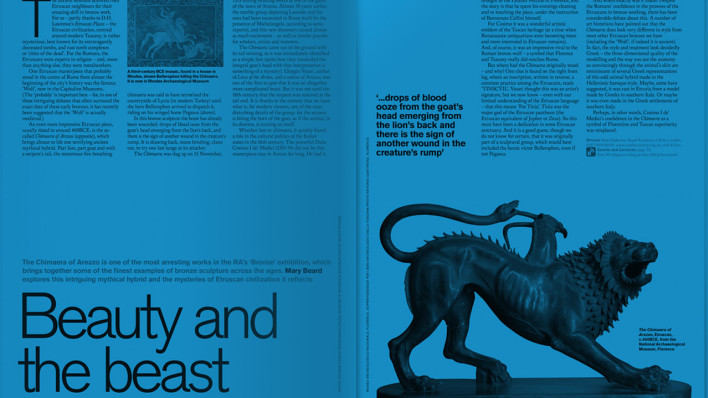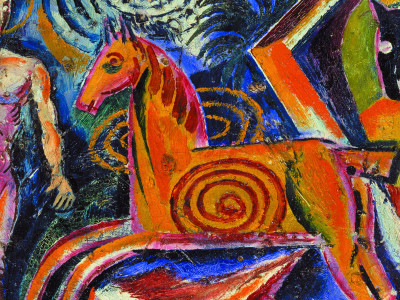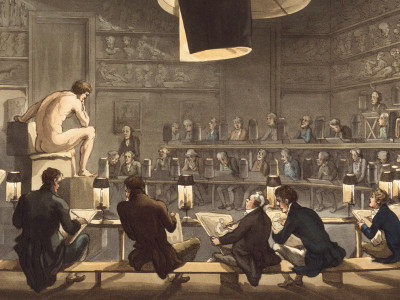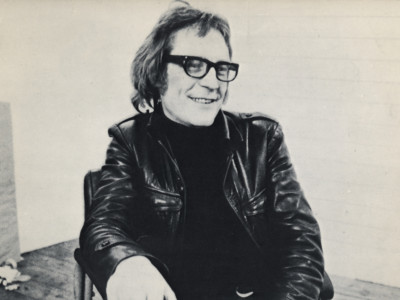
The tale of Russia's revolutionary ceramics
By Emma Crichton-Miller
Published on 14 March 2017
Emma Crichton-Miller charts the fortunes of St Petersburg’s porcelain factory, from supplier of exclusive editions to the Russian court, to producer of high end Soviet agit-prop.
From the Spring 2017 issue of RA Magazine, issued quarterly to Friends of the RA.
In 1744, the Russian Empress Elizabeth founded the first factory in Russia for the manufacture of porcelain. Her father, the europhile Peter the Great, had encountered the dazzling white china of Meissen on a visit to Dresden in 1718, but had been thwarted in his efforts to bring porcelain production to Russia. Under Elizabeth, however, an ingenious young mining engineer, Dmitri Vinogradov, developed his own recipe.
At the Imperial Porcelain Factory in St Petersburg teams of craftsmen fed the insatiable demand of the Russian court for a wide variety of objects, from exquisitely enamelled dinner services, tea services and candelabra, to walking-stick handles, Easter eggs, sweetmeat dishes, presentation platters and commemorative figurines. Porcelain was definitively Imperial in origin and Imperial in destination, its wares reserved exclusively for the Romanovs and the Russian court.
In October 1917, the chaos that followed the Bolshevik seizure of power in Petrograd unleashed Utopian exhilaration and rage-filled anarchy in equal measure, and the porcelain factory to the south of the city on what is now Obukhovskoy Oborony Prospekt was deemed an anachronism. Its name had already been changed in February 1917 to the State Porcelain Factory, after Tsar Nicholas II had been forced to abdicate. A skeleton staff, occupied during the war in making porcelain for the Imperial army and army hospitals, had simply carried on under the provisional government, making objects according to pre-Revolutionary models. Without a market, however, the decorative painting and sculpture departments faced closure.
Instead, in a remarkable episode characteristic of the rapid shifts and bewildering transformations of the time, the October revolution provided a reprieve that gave porcelain a new purpose. Confronting the need to marshal the liberated but starving millions of Russia behind the Bolshevik vision, and in response to a wartime dearth of materials, Lenin saw in the undecorated plates lying in the Factory’s vaults – the surplus from several Romanov reigns – an immediate resource. As the RA’s show Revolution: Russian Art 1917–1932 reveals, alongside banners, posters, monumental plaster statues, films and photography, china was recruited to the Communist cause. The white surface of porcelain became a blank canvas for some of the most directly political and ardently contemporary ceramic art of the 20th century. What more potent medium could there have been for experiments in creating a new, revolutionary aesthetic, fit to address the needs and dreams of the peoples of a Russian Soviet Federative Socialist Republic, than plates once destined for the Tsars’ tables?

Plate with a depiction of the Second Interim Wooden Mausoleum of Vladimir Lenin (which preceded the present granite mausoleum), 1924

Plate with the inscription ‘Workers’ Victory 25 Oct’ on a red banner, 1919
It was the writer and political ally of Lenin, Anatoly Lunacharsky, head of the People’s Commissariat of Education (Narkompros), and the painter David Shterenberg, head of its Fine Art Department, who saw the potential of ceramics, alongside other art forms, to project the Bolshevik message at home and abroad. They provided fuel and money and encouraged the artists to experiment. They appointed Piotr Vaulin, a former director of the Abramtsevo Ceramic Studio in Moscow, as one of the factory’s directors. A Narkompros directive urged employees, while preserving the best traditions of Russian decorative porcelain, to produce pieces "revolutionary in content, perfect in form and flawless in technical execution".
Sergei Chekhonin, meanwhile, a successful graphic designer and affiliate of the prewar Mir Iskusstva (World of Art) group of artists, was elected the Factory’s first artistic director. He blazed a trail, creating powerful, colourful designs that drew at different moments on the radically contrasting styles of neo-classicism, Cubism, folk art and pre-war satirical pamphlets. Many featured revolutionary slogans or even Biblical sayings and classical aphorisms in dancing Russian letters: "He who is not with us is against us"; "Struggle gives birth to heroes"; "The mind cannot tolerate slavery". He developed a style of elegant floral calligraphy, and adopted the Imperial gold to assert the Revolution’s legitimacy. He and his colleagues produced a continuous stream of inventive variations on the monogram of the new state – hammer and sickle – and ran revolutionary red painted ribbons round the edges of the plates decorated with tools, flowers and leaves. A new stamp, incorporating hammer, sickle and cog, was designed by Alexis Eremeevich Karev. Plates were produced to mark the anniversaries of the revolution, international Communist congresses and to celebrate May Day.
Some established artists produced designs for the factory – including Vladimir Lebedev and Wassily Kandinsky – and some ceramicists from the pre-revolutionary era – such as Zinaida Kobyletskaya and Rudolf Vilde, eventually head of the factory’s painting workshop – turned their skills to new purposes. But equally important was Chekhonin’s recruitment of new, talented artists to the art department, creating a nursery of gifted painters who brought their distinctive sensibilities to bear on the white wares. Alexandra Shchekotikhina-Pototskaya, from a family of Old Believers, steeped in traditions of icon painting, book illumination and embroidery, and who, as a student, had travelled through northern Russia with fellow artist Maria Lebedeva, studying Russian peasant and folk art, revelled in the colours and forms of traditional art, although her subject matter was resolutely contemporary. Lebedeva, meanwhile, infused her painterly pieces with revolutionary symbolism – the Red Star, smoking factories, telegraph wires and the smiling liberated peoples of the world.
Experimental revolutionary porcelain was not restricted to the State Porcelain Factory, but flourished elsewhere, in the new Higher State Art-Technical Studios and other training institutions, in both Moscow and Petrograd. Mikhail Adamovich, who served in the Red Army between 1919 and 1921, produced angular, modernist designs honouring those heroes of revolution, Trotsky and Lenin. A plate Adamovich designed at the Dulevo Porcelain Factory, Moscow, with its assertively geometric, Futurist design, depicts the second structure to house the preserved body of Lenin. Adamovich enhances its grandeur, superimposing a five-pointed star and placing it against a backdrop of sun rays, as if it were a neo-classical masonic temple. The plate exemplifies the ironies of using the language of Western modernism to extoll an anti-Western, anti-capitalist regime on objects which would then be sold to the capitalist West for hard currency.
Natalia Danko, who had trained as a sculptor under Vasily Kuznetsov, came with him to the State Porcelain Factory when he was appointed head of the sculpture workshop, and herself took over as the workshop’s head in 1919. Inspired by the folk tradition of ceramic figurines, Danko chose her subjects from everyday post-revolutionary life – soldiers, sailors, militia women, factory workers, flower sellers – chronicling in 311 works, over 313 months, the changing priorities of Soviet Russia.

Woman Embroidering a Banner, 1919

Decorative vase depicting ‘The Liberated People’, with Vladimir Lenin’s portrait below banners and scenes of life in different nations, 1929
In the early heady days of the revolution, these artists were driven by a common sense of purpose, weaving from the forms of the past and the ideas of the present a new vocabulary of ceramic decoration. According to the noted authority on revolutionary ceramics, Nina Lobanov-Rostovsky, although the artists often had to work for hours at long tables with their coats and mittens on, enduring food and fuel shortages, "they later remembered it as an exciting and exhilarating time… and they managed to express some of this excitement in their work." She adds, "They were aware that they were part of an important propaganda campaign and that their art had a valued place in Soviet life."
Although artistic porcelain comprised only ten per cent of the State Porcelain Factory’s output, it was highly regarded. And while the pieces were priced beyond the reach of most workers, they were snapped up by collectors in Petrograd from the new shop on Nevsky Prospekt. In one tragic instance of futility, however, a series of 23 remarkable dishes and plates, designed by the factory’s leading artists to raise money for the starving population of the Volga region during the famine of 1920–21, did not leave the factory as the charity auction was cancelled.
From 1921, with the introduction of the New Economic Policy, the Narkomindel (Foreign Office) reserved the entire artistic output of the factory for its own purposes, sending out full services to new Soviet embassies and raising hard currency through sales at international trade fairs. Some Soviet propaganda plates have inscriptions in German; the new Bolshevik state’s First Russian Art Exhibition in Berlin in 1922 had uncovered a tremendous appetite for Russian avant-garde design. At the Exposition Universelle in Paris in 1925, Russian porcelain designers were awarded a gold medal. As Natalia Murray, Lecturer in Russian Art at the Courtauld Institute, and co-curator of the RA’s show puts it, "in the end, it became propaganda for the West, important for its creation of the image of Soviet Russia abroad."
But if most Soviet porcelain of the time was agit-prop in content, however beautifully accomplished, there was one strand that leapt into a new creative sphere. In 1923 Chekhonin was sent to take over artistic direction of a factory near Novgorod. Meanwhile, in 1922, a breakaway group of Suprematist artists, led by Kazimir Malevich, and including Nikolai Suetin and Ilya Chashnik, arrived in Petrograd, determined to put Suprematist ideas to work in a practical context. They were invited to work in the factory.

Vase with ornamental Suprematist elements, 1930

Plate with Suprematist composition, 1923
Back in 1915, Malevich had unveiled his radical painting, Black Square, at The Last Futurist Exhibition: 0.1 in Petrograd, declaring: "It is from zero, in zero, that the true movement of being begins." His demand for a revolution in visual culture had many sympathisers, including Marc Chagall, who had invited him to teach at Vitebsk Art School in 1919. There Malevich founded the group UNOVIS (The Champions of the New Art) to explore further his Suprematist ideas of an art of pure feeling, articulated through a grammar of coloured geometric forms. For the Suprematists, the colour white was suggestive of infinity, so the porcelain plates of the State Porcelain Factory offered an ideal "zero" ground for their geometric designs.
The Suprematist vocabulary of circle, square, rectangle and triangle was readily taken up by other designers – and indeed in 1932, when Suetin became art director, these motifs had a further run. But for Malevich, simply painting Suprematist motifs on white plates, many still with the stamp marks of the Tsars on their base, was insufficient. In 1923 he began to create ceramic wares according to volumetric Suprematist principles he had explored with El Lissitzky in Vitebsk. His bisected teacups and famous sculptural teapot, an essay in the disposition of geometric forms in three dimensions, are triumphant expressions of the will to transform the material world as completely as the spiritual.
By 1932 such optimism had died. After a second stint at the factory, between 1925 and 1927, Chekhonin had fled to Paris. In 1927 Malevich had been recalled suddenly to Russia from an exhibition of his work in Berlin, arrested and interrogated. Experimental artists, rather than being co-creators of a new world, were increasingly viewed as enemies of the state. In 1925, on the 200th anniversary of the Russian Academy of Science, the factory was renamed the Leningrad Lomonosov Porcelain Factory in honour of the great 18th-century scientist Mikhail Lomonosov, and gradually turned its attention to animal figurines and polite dinner services for the export market. The products of the earlier period, however, remain a testimony to another era of political hope and creative excitement.
Emma Crichton-Miller is an arts writer for the Financial Times, Prospect and Apollo.
Revolution: Russian Art 1917–1932, Main Galleries, Royal Academy of Arts, 11 February – 17 April 2017.

Enjoyed this article?
As well as free entry to all of our exhibitions, Friends of the RA enjoy one of Britain’s most respected art magazines, delivered directly to your door. Why not join the club?
Related articles

Visions from Ukraine
19 June 2024

10 RA Schools stories through the centuries
16 May 2024

In memoriam: Mick Moon RA
1 May 2024